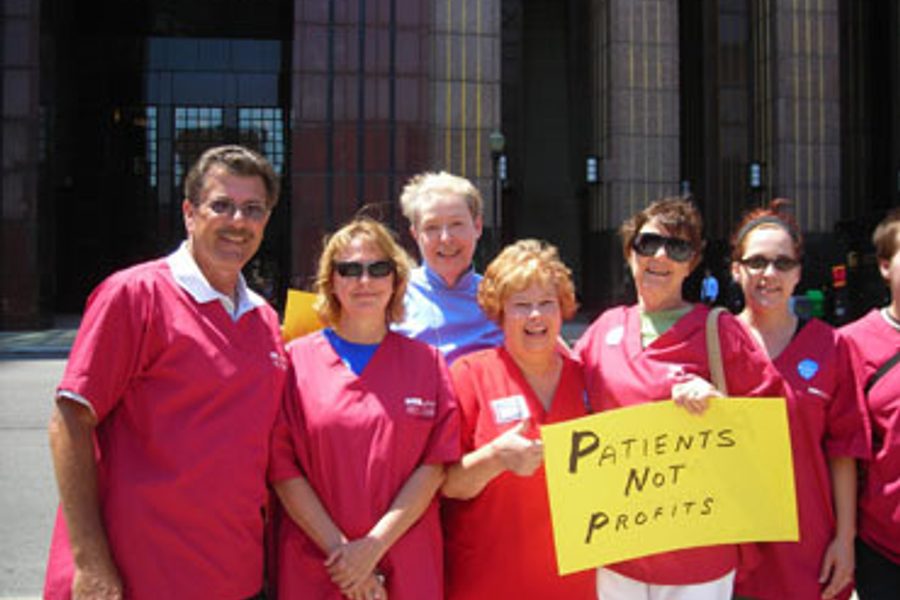
As Congress puts the finishing touches on its bruised and battered health care reform legislation, pointed criticism has emerged from the left alongside reactionary opposition from the right. For labor, it’s a mixed bag at best; the AFL-CIO is still lobbying for a public option; National Nurses United has rejected the bill outright as a massive handout to insurance companies that will utterly fail to solve the crisis in affordability and access.
But besides expanding insurance (for better or worse), the reform bill hits at a less publicized labor issue: it could help change the face of the medical workforce, promoting diversity to improve care for the most vulnerable populations.
The stunning racial and ethnic disparities in the health care system (gaps in disease rates and coverage) are a measure of its brokenness. And research suggests that a major factor in these inequalities is the background and identity of care providers. Race and language have a complex influence on how care is delivered and how patients respond.
In medicine, “cultural competency” means understanding, for instance, how to integrate a patient’s traditional ritual and healing practices into their treatment; or why white doctors’ stereotypes may lead to subconscious discrimination when assessing an immigrant patients’ needs.
But building a culturally competent health infrastructure involves creating a workforce that reflects the communities they serve. Today, according to the Center for American Progress, “Hispanics account for 12 percent of the population, but only 2 percent of nurses and 3.5 percent of physicians. Less than one in 20 doctors or dentists are African American, even though one in eight persons in the United States are African American.” The pending overhaul will further strain the thinning physician workforce as more people are pushed into the insurance system.
For all their flaws, the House and Senate proposals do seek to narrow these health disparities. The bills contain several key measures that could boost the representation of people of color in the health care workforce, including physicians as well as nurses and other support staff. A proposal for expanding community health centers would improve access to care in poor urban neighborhoods and remote rural regions. The Senate bill would provide grants for demonstration projects aimed at encouraging low-income workers to climb the career ladder in the health care sector. Under the House bill, the Health Careers Opportunities Program would expand loans and scholarships to students from disadvantaged backgrounds. (The single-payer bill HR 676 also includes diversity-related provisions.)
These measures make political sense as well. Improving the health of the most medically disenfranchised groups is key to controlling costs.
According to an analysis of medical expenditures from 2003 to 2006 by the Joint Center, “Eliminating health disparities for minorities would have reduced direct medical care expenditures by $229.4 billion.”
The bottom line is that diversifying the health care workforce would improve the system’s responsiveness to the needs of people of color, in addition to bringing economic opportunity to those communities and reducing costs for the entire country. So do those features redeem the weakened health care legislation? Probably not if you’re sticking to the core principle underlying radical reform initiatives: that health care is a human right.
Expanding and diversifying the workforce is critical to any overhaul that is cognizant of the country’s intense health disparities. Yet activists who call for a total restructuring of health care point out that, as long as insurance profiteers are allowed to hold the country’s health hostage, inequality will remain a fixture in the health system. After all, bilingual staff and community clinics,while certainly needed, won’t relieve the plight of the millions of undocumented immigrants excluded by law from the “overhauled” system. The overwhelming whiteness of the health workforce is a symptom of overarching race and class disparities afflicting all aspects of society.
Still, whether you think the pending reforms will revamp health care or worsen it, there’s one major breakthrough that could come out of the workforce provisions: Democratization of the health care workforce has the potential to fuse medicine with social change. Surveys of graduating medical students reveal that, compared to whites, a much higher proportion of Black, Latino and Native American graduates hope to return to their communities to practice. The California and national nurses unions have used the patient-practitioner link as a cornerstone of their progressive, pro-single-payer reform platform.
Although politicians have turned the health care debate into a partisan morass, one bright spot is that Washington’s piecemeal reforms may clear the path for a sea change at the grassroots level. In the long run, it may fall on health professionals who understand the communities they serve, and who grasp the injustices pervading the current system, to lead the movement toward truly universal care.
Michelle Chen is a contributing writer at In These Times and The Nation, a contributing editor at Dissent and a co-producer of the “Belabored” podcast. She studies history at the CUNY Graduate Center. She tweets at @meeshellchen.








